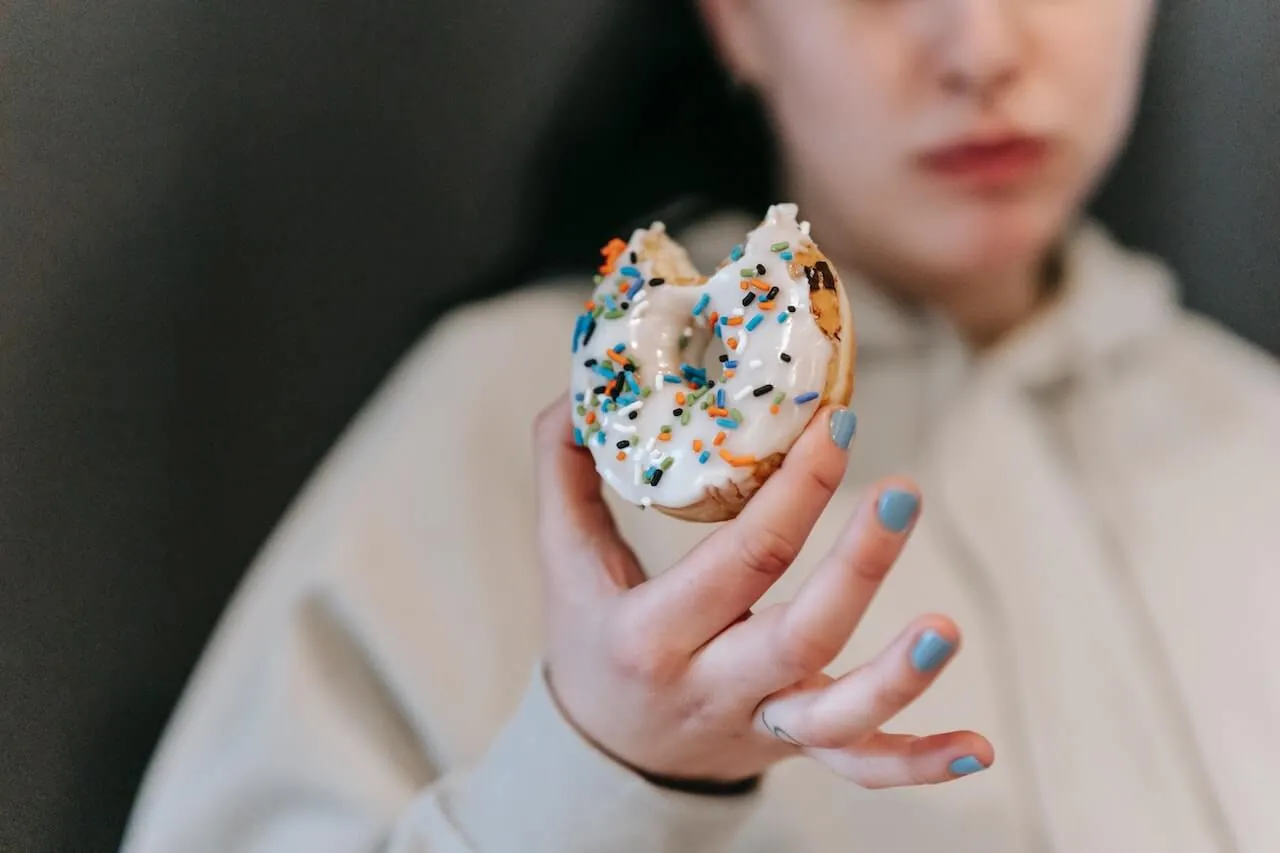Tracking your total carbohydrate intake is the foundation of blood sugar control, especially for those with type 2 diabetes. However, not all carbs are created equal. Complex carbohydrates are rich in fiber and digest slowly to provide a steady release of energy, while simple carbs (like sugar) are digested quickly. Both can fit into a well-balanced diet, but simple carbs may have a rollercoaster effect on your blood sugar levels if not consumed mindfully.
The amount of sugar you consume can impact more than just your blood glucose levels. It can contribute to long-term health concerns like heart disease, liver disease, obesity, and more. Research has linked high dietary sugar consumption with an increased risk of metabolic disease, highlighting the importance of monitoring your overall intake. Several tools like the glycemic index, continuous glucose monitors (CGMs), and food-tracking apps can help you keep track of your nutrition. Still, few are more accessible than food labels and guidance from your healthcare provider.1
This article discusses the impact sugar can have on overall health and offers tips for reducing the risks associated with overconsumption.
{{mid-cta}}
Sugar and Diabetes: What Is the Link?

When it comes to sugar, people living with diabetes can't live with it and can't live without it. You can pretty much say that diabetes and sugar have a complicated relationship. Our bodies, whether we have diabetes or not, need the sugar glucose to function as it's the brain's primary source of energy. But that's no invitation to add more glucose to your diet; the body can produce glucose by breaking down most things you eat, especially carbohydrates.2
Now, let's get to where the issue lies. Insulin is a hormone that moves all the sugar in the bloodstream into your cells to use as energy. When you have diabetes, your pancreas can't produce enough insulin, or your cells don't respond to the insulin efficiently. If they can’t respond to insulin appropriately, they can't use the sugar as fuel, resulting in a condition known as insulin resistance—either scenario results in all that sugar remaining in your bloodstream.
Excess sugar can lead to blood vessel and nerve damage, which increases your risk of chronic health problems, including cardiovascular disease, heart attack, stroke, and high blood pressure. If diagnosed with type 1 or type 2 diabetes, your doctor might prescribe insulin injections to help regulate your blood sugar levels and manage the condition.3, 4
Too much added sugar too often can cause rapid spikes in your blood glucose levels, which requires your body to produce more insulin, eventually leading to insulin resistance and type 2 diabetes. But sugar isn't the only contributing factor: smoking, a sedentary lifestyle, and obesity can all contribute to developing the disease.
How Much Sugar Can People With Type 2 Diabetes Eat Daily?
Living with prediabetes or diabetes isn't synonymous with forgoing fruits, grains, dairy, or even dessert. After all, sugar is the brain and body's primary energy source and can fit into a diabetes-friendly diet in moderation. Moderation is the keyword here.
While there aren't any guidelines for how much sugar a diabetic can consume daily, there are recommendations for the general population. The American Heart Association recommends the following limits for added sugar per day:5
- Men: 36 grams (equivalent to 150 calories or nine teaspoons' worth)
- Women: 25 grams (equivalent to 100 calories or six teaspoons' worth)
However, other government agencies are more lax. The Centers for Disease Control and Prevention (CDC) recommends getting no more than 10% of your total daily calories from added sugar, which comes out to 50 grams of added sugar (equivalent to 200 calories or 12 teaspoons' worth) on a 2,000-calorie diet.6 For reference, a typical 12-ounce can of sugar-sweetened soft drink has more than 30 grams of sugar.7
Remember that these guidelines only make recommendations for added sugar, not natural or total sugars. Many nutrient-dense whole foods that offer various health benefits, such as fruits, vegetables, and dairy products, contain natural sugars and may be beneficial to your diet.
While people with diabetes need to keep their total sugar intake low, there aren't specific guidelines for how much they should aim for each day. Everyone is different, and how one food affects their blood glucose levels can differ from another person's reaction. That's why it's so important to work with their diabetes care team to figure out the best way to keep their blood sugar levels in a healthy range.
What Are the Risks of Too Much Sugar?
Healthy eating is all about balance, but consuming too much sugar in one sitting can be dangerous, especially for those with type 2 and type 1 diabetes. After consuming sugar, your blood glucose levels go up, and, in most cases, the body uses that glucose for energy. However, when you eat too much sugar, the body can’t keep up and may not process the sugar effectively.
Eating a large amount of sugar can cause a rapid spike in your blood sugar, followed by a flood of insulin from the pancreas to correct the high levels. As a result, your blood sugar levels resemble a rollercoaster with dramatic highs and equally dramatic lows. Research has shown that these glucose fluctuations are a significant risk factor for oxidative stress in people with type 2 diabetes. Over time, this chronic inflammation can increase the risk of diabetes-associated complications like weight gain, kidney damage, diabetic neuropathy, heart disease, and poor wound healing.8
While it’s essential to track your overall carbohydrate intake with diabetes, it’s important to remember that not all carbs are created equal. Some carbohydrates are fiber-rich and require more time to digest, resulting in a steady release of energy. Simple carbs, on the other hand, are digested quickly and may cause a rapid increase in your blood sugar levels. For this reason, it’s essential to monitor your sugar consumption and your body’s response to it.
Hidden Sugars: What Are They and How Do They Affect Your Sugar Intake?

Sugar goes by many different names because there are so many different types. Sugar can come from fruits, syrup, malts, and other sources — and you might see it listed on food labels as seemingly healthy ingredients, such as coconut sugar, cane sugar, fruit juice, date syrup, agave, brown rice syrup, and others. Plus, anything ending with the suffix "-ose" is also a code word for sugar. Next time you're scanning food labels, look out for the following hidden terms on ingredient lists:10
- Anything ending with "ose," such as fructose, sucrose, dextrose, and maltose
- Table sugar
- High-fructose corn syrup
- Fruit juice
- Agave
- Honey
- Molasses
- Maple syrup
- Rice syrup
- Maltodextrin
- Maltol
- Treacle
<div class="pro-tip"><strong>Also Read: </strong><a href=the-hidden-sugar-trap>The Hidden Sugar Trap and Travel Tips with Alyssa Wilson/a></a>.</div>
The Importance of Food Labels to Manage Your Sugar Intake
Food labels are among the most accessible and reliable tools for monitoring sugar intake. They provide essential information on a food’s serving size and carbohydrate content, giving you insight into portion control and how it will affect your blood sugar levels. Thankfully, as of 2021, food labels must also include the amount of added sugar in a product, making it easier to differentiate between added and natural sugars.9
The ingredients list is also a handy tool. Nutrition labels list ingredients by weight in descending order, meaning the ingredient with the most weight in the product is listed first. This can help people with diabetes determine where a food’s sugar comes from. Examples of added sugars may include honey, high-fructose corn syrup, glucose syrup, inverted sugar, sucrose, and dextrose.
By checking the nutrition facts and ingredients list on a food product, it’s easier to identify hidden sources of added sugar and adjust your dietary intake accordingly. Making informed food choices using the food label can be a game-changer for diabetes and body weight management. A registered dietitian can help you navigate your nutrient needs and learn how to read a food label. Knowledge is power, after all!
8 Tips to Keep Your Sugar Intake in Line
Limiting your sugar consumption is a smart idea because it helps you avoid blood glucose spikes, keeping your levels steady and healthy. Avoiding highly refined processed and packaged foods, such as candy, pastries, soda, and other sugar-sweetened beverages, is a great place to start. Still, many different foods are sneaky sources of sugar. That's why it's so important to read nutrition facts labels.
A food's nutrition label will reveal how many total carbs it contains and carbs from sugar and fiber. Sticking to foods low in total carbs and added sugar can help keep blood glucose spikes at bay, but here are some simple ways to limit and control your sugar intake:
- Avoid sugary drinks like soda and instead go for plain water or flavored seltzer. You can enjoy artificially sweetened drinks in moderation.
- Swap sugary condiments like barbecue sauce and ketchup for mustard or light mayo.
- Buy plain yogurt instead of the sweetened varieties, and flavor it yourself with a handful of berries and nuts.
- Use no-added-sugar jarred pasta sauce, or make homemade marinara without added sugar.
- Instead of making a PB&J, spread no-added-sugar peanut butter on whole-grain toast and top it with berries.
- If you use plant-based milk alternatives, make sure they don't contain any added sugar.
- Skip the balsamic dressing on your salad and use apple cider vinegar instead.
- Swap a fraction of the sugar called for in a recipe with an artificial sweetener of your choice.
Using a CGM with Signos: Real-Time Data, Backed by AI
Choosing low-carb, nutrient-dense foods and tracking your blood sugar levels are two of the most important things you can do to manage your diabetes and improve your health. But keeping tabs on your diet doesn't have to be difficult.
I'd like you to please lSignos pairs a real-time glucose biosensor with AI trained on tens of millions of data points to deliver personalized, science-backed guidance for weight management and health. See exactly how your body responds, and take action.
Learn how it works. Ready to get started? Join now.
<div class="pro-tip"><strong>Learn More: </strong><a href=does-sugar-cause-type-2-diabetes>Does Sugar Cause Type 2 Diabetes?</a>.</div>
Topics discussed in this article:
References
- NIH News in Health. (2017, September 8). Sweet Stuff. https://newsinhealth.nih.gov/2014/10/sweet-stuff
- Centers for Disease Control and Prevention. (2022, June 20). Diabetes and your heart. https://www.cdc.gov/diabetes/library/features/diabetes-and-heart.html
- Mayo Clinic. (2023, March 14). Type 2 diabetes. https://www.mayoclinic.org/diseases-conditions/type-2-diabetes/symptoms-causes/syc-20351193
- American Heart Association. (2021, November 2). Added Sugars. https://www.heart.org/en/healthy-living/healthy-eating/eat-smart/sugar/added-sugars
- Centers for Disease Control and Prevention. (2021, November 28). Get the facts: Added sugars. https://www.cdc.gov/nutrition/data-statistics/added-sugars
- American Diabetes Association. (n.d.). Get smart of carbs. https://diabetes.org/healthy-living/recipes-nutrition/understanding-carbs
- University of California San Francisco. (n.d.). Hidden in plain sight. https://sugarscience.ucsf.edu/hidden-in-plain-sight/




.svg)










.svg)
.svg)
.svg)
.svg)
.svg)
.svg)
.svg)
